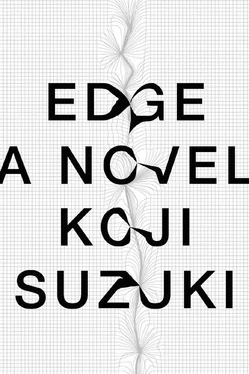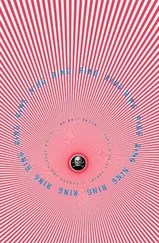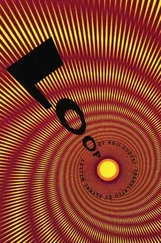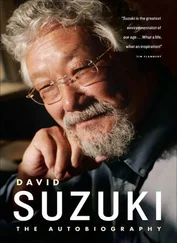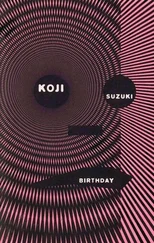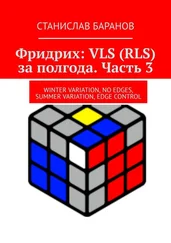Koji Suzuki - Edge
Здесь есть возможность читать онлайн «Koji Suzuki - Edge» весь текст электронной книги совершенно бесплатно (целиком полную версию без сокращений). В некоторых случаях можно слушать аудио, скачать через торрент в формате fb2 и присутствует краткое содержание. Город: New York, Год выпуска: 2012, ISBN: 2012, Издательство: Vertical, Жанр: Ужасы и Мистика, на английском языке. Описание произведения, (предисловие) а так же отзывы посетителей доступны на портале библиотеки ЛибКат.
- Название:Edge
- Автор:
- Издательство:Vertical
- Жанр:
- Год:2012
- Город:New York
- ISBN:978-1-935654-95-7
- Рейтинг книги:4 / 5. Голосов: 1
-
Избранное:Добавить в избранное
- Отзывы:
-
Ваша оценка:
- 80
- 1
- 2
- 3
- 4
- 5
Edge: краткое содержание, описание и аннотация
Предлагаем к чтению аннотацию, описание, краткое содержание или предисловие (зависит от того, что написал сам автор книги «Edge»). Если вы не нашли необходимую информацию о книге — напишите в комментариях, мы постараемся отыскать её.
Edge — читать онлайн бесплатно полную книгу (весь текст) целиком
Ниже представлен текст книги, разбитый по страницам. Система сохранения места последней прочитанной страницы, позволяет с удобством читать онлайн бесплатно книгу «Edge», без необходимости каждый раз заново искать на чём Вы остановились. Поставьте закладку, и сможете в любой момент перейти на страницу, на которой закончили чтение.
Интервал:
Закладка:
The computers were functioning normally. There was no error in the programs. And yet two trials had simultaneously yielded the same result. And that result conflicted with the mathematical theorem that Pi was both irrational and transcendental. This couldn’t be happening. There was simply no logical explanation.
When the four programmers ran the calculations again on yet another computer and came up with the same findings once more the next day, they decided to inform Dr. Jack Thorne, a professor of physics at the university and a global authority on quantum gravity theory.
Jack Thorne sank into the sofa in his office and closed his eyes. A Christmas carol filled his ears. The music wasn’t real. The atmosphere of the holiday season always prompted Jack’s ears to conjure up Christmas music. He rather enjoyed it, actually. In his reverie, he imagined he was in Stockholm at Yuletide.
It was fair to say that Jack was inclined to be absentminded. He had a habit of considering a matter while his thoughts wandered here and there; when the two topics converged, he sank into a still deeper state of contemplation.
His eyes opened to the sight of the door that separated his office from the hallway — the one the four young researchers had exited through just moments ago after bringing him their report. Briefly, Jack imagined the door as a wormhole connecting his office to another universe. He had dedicated his life to researching wormholes and had been awarded a Nobel Prize for his achievements.
He understood what Gary and the others were telling him. If today had been the first of April, he would have laughed them off and complimented them on the joke.
But what to make of this?
Jack’s gaze left the door and wandered off to the right, following the wall and settling on a familiar artwork. It was a Japanese ink painting he’d purchased at an old gallery in Stockholm. The landscape was rendered in shades of black, contrasting strangely with the old cityscape of Stockholm, but it was that juxtaposition that had convinced Jack to purchase it.
The painting was primarily composed of three elements: mountains, a river, and a bridge. It was a fairly mundane composition, really, with the mountain range in the background, the meandering stream in the foreground, and the bridge in between. The bridge occupied the middle of the painting, a chain of three semicircles connecting to the opposite shore. One never saw bridges like this in the modern-day U.S. It was probably built of pieces of wood skillfully stacked to form its arches, yielding a structure sufficiently solid to walk across.
Yes. The value of Pi .
The report on Jack’s desk once again claimed his attention.
A pattern emerged in the value of Pi? Endlessly repeating zeros, no less?
Jack scrutinized the facts once more. Four extremely talented mathematicians had run calculations on different computers and come up with the same results. Somewhere past the five hundred billionth digit, the programs began to spin out endless zeros. The four programmers were at a loss as to how to interpret the findings and had brought the matter to a specialist in quantum gravity theory.
Perhaps this was where the tides were taking them.
The Riemann hypothesis governed the regularity of the behavior of prime numbers. Even though it was a component of number theory and pure mathematics, it was often said to have a deep connection to quantum mechanics as well. Here at the university, Jack Thorne had discovered a number of other instances in which quantum mechanics methodology had illuminated a path to solving difficult problems in number theory. From that standpoint, Jack understood why Gary and the others had felt inclined to bring their bizarre report to a professor of quantum gravity theory.
They must have concluded that it surpassed the bounds of mathematics. As such, they probably have no inkling of the phenomena this implies .
Jack popped a green-tea teabag into his cup and added water from his pot. He took several sips, but the tea didn’t scald him. In fact, he felt frozen to the core. He imagined he could feel icy tendrils creeping up from the base of his spine.
Other than the one on his wall, Jack had seen a number of ink paintings in his time. He was drawn to their delicate, monochromatic simplicity and the shadowiness they harbored, so unlike oil paintings. But whenever he saw one, the same question always plagued him.
In all of the ink paintings I’ve ever seen, there’s never a single person depicted, even off in the background. Why don’t people ever appear in ink paintings?
When Jack realized that his cup was empty, he refilled it with hot water from the pot. Even though the heat was controlled by a thermostat, he couldn’t shake the sensation that the room was getting colder by the minute.
In the microscopic realm of elemental particles, objects ceased to be objects. When you became deeply immersed in that world, you saw that the visible one constituted only the merest slice of the ever-repeating phenomena of life and death, and concepts of permanent existence quickly became a long-lost dream. The real number line seemed one-dimensional, but between the integers three and four, for example, there existed infinite irrational numbers, transcendental numbers and so forth, writhing and wriggling like microscopic organisms. As a physicist, Jack didn’t see the number line as one-dimensional. Nor did he perceive it as two-dimensional or three-dimensional. Beyond the strings of randomly repeating numbers, he sensed a bottomless abyss that almost seemed to imply a pathway to another dimension.
A hypothesis had pushed its way into Jack’s mind, but it was an idea he preferred not to speak aloud.
If we look at the number line in terms of the quantum world, fluctuations in the value of Pi might be possible .
What could the odds have been of a world like ours emerging through the Big Bang and the birth of the universe? Jack’s friend Lee Smolin estimated them to be one in 10ˆ299, while the arithmetic-loving Roger Penrose had come up with the figure of one in 10ˆ(10ˆ123). Numerically the values were vastly different, but the implications were the same. The odds for the string of coincidences necessary to create our universe were basically nil.
The universe was comprised of just two types of constructs: astronomical entities and life forms. Mountains and rivers were part of astronomical entities, while tools were the creation of humans and other life forms. Constructs of life and astronomical entities were supported by infinite physical constants. These could be compared to adjustable dials whose fine-tuned calibrations served to maintain the world as we know it. Moreover, the majority of physical constants were related to Pi through basic equations.
Jack felt as if an icy lump in his stomach was melting, sending rivulets of cold throughout his body. He had begun shivering intermittently, and soon the trembling became constant and his teeth chattered violently.
It was only a hypothesis. But just contemplating the implications, Jack was so deeply disturbed that he couldn’t stop shaking.
There had been a change in the value of Pi. And it involved a string of the heretical number that had struck terror in men’s hearts since ancient times: zero.
This is just a new bridge humankind must now cross , Jack told himself. In his mind, the semi-circular bridge in the ink painting quietly crumbled.
Chapter 1: Missing
November 5, 2012
Saeko Kuriyama awoke with a start, her heart thumping wildly. Almost as if her heart had taken over her entire body, its pounding emanated outwards, causing her breasts to twitch with its surging pulsations. Today, yet again, Saeko was unable to get up for several moments after awakening.
Читать дальшеИнтервал:
Закладка:
Похожие книги на «Edge»
Представляем Вашему вниманию похожие книги на «Edge» списком для выбора. Мы отобрали схожую по названию и смыслу литературу в надежде предоставить читателям больше вариантов отыскать новые, интересные, ещё непрочитанные произведения.
Обсуждение, отзывы о книге «Edge» и просто собственные мнения читателей. Оставьте ваши комментарии, напишите, что Вы думаете о произведении, его смысле или главных героях. Укажите что конкретно понравилось, а что нет, и почему Вы так считаете.
